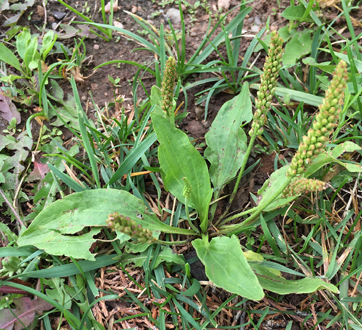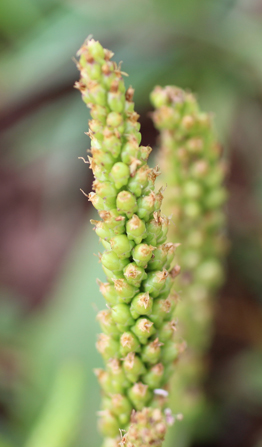
Location
In front of Visitor Center ((N35D33'01.302 X W105D41'10.139)
Flowers first observed: 8/11/17
The Plant w/Flowers

The Flowers

Distribution
"Ecology: Weed of wet areas from 2,000-8,500 ft (610-2591 m); flowers May-October. Distribution: Native to Eurasia and naturalized throughout the world. In North America it is especially common in the Rocky Mountains and the middle to high elevations of the Southwest." (SEINet)
Description
"Acaulescent perennial herb to 42 cm tall. Growth form is a basal rosette of petioled leaves with multiple spicate inflorescences, taller than the leaves, ascending from within the rosette. Leaves: Petiolate with broadly ovate blades, up to 30 cm long, including the petiole; blades thick and distinctly 3-5 veined, sparsely pubescent, becoming glabrate, margins with shallow lobes near base. Flowers: Pedunculate spikes 3-24 cm long, interrupted near base; peduncle 4-20 cm long, sparsely pubescent to glabrous, appearing ridged or four-sided; flowers perfect, each subtended by a bract; bracts broadly ovate, 1.5-4.5 mm long, broadly scarious-margined with a glabrous midvein; sepals 4, broadly ovate to elliptic, 1-2 mm long, broadly scarious margined with a glabrous midvein; corolla 4-lobed, lobes spreading or reflexed, ovate, about 1 mm long, whitish and scarious; 4 stamens. Fruits: Capsule ovoid, breaks below middle, contains 6-many irregularly shaped seeds." (SEINet)
Ethnobotanical Uses
Food:
"Acoma Unspecified Young leaves used for food. ---Keres, Western Unspecified Tender shoots used for food.---" (Moerman 417)
"---Young leaves have been eaten raw in salads and sandwiches, but they soon become tough and stringy. Cooking improves palatability and makes it possible to remove some of the tougher fibers. Fine chopping may also make older leaves easier to eat. The flavor has been likened to that of Swiss chard (Beta vulgaris). Plantain seeds can be dried and ground into meal or flour for use in bread or pancakes." (Kershaw 199)
Medicine:
"---Isleta Gastrological Aid Infusion of leaves used as a stomach tonic.---" (Moerman 417)
"Plantains are rich in vitamins A,C and K. The leaves and leaf juice have been widely used in poultices and lotions for treating insect bites and stings, snake bites, sunburn, poison-ivy rashes, sore nipples, blisters, burns and cuts. Plantain leaves have also been heated and applied to swollen joints, sprains, strained muscles and sore feet. In Latin America, common plantain is a prominent folk remedy for treating cancer. Plantain tea has been used for centuries to treat sore throats, laryngitis, coughs, bronchitis, tuberculosis and mouth sores. These plants are said to have anti-inflammatory effects. Also, they contain flavonoids (which are anti-bacterial), allantoin (a soothing compound that promotes healing of injured skin cells) and tannin (whose astringency helps to draw tissues together and stop bleeding). Primary studies indicate that plantains may reduce blood pressure, and their seeds have been shown to reduce blood cholesterol levels. Plantain seeds are rich is mucilage, and they were widely used as a source on natural fiber, with laxative effects. They were also used in medicinal teas for treating diarrhea, dysentery, intestinal worms and bleeding of mucous membranes. The roots were recommended for relieving toothaches and headaches and for healing poor gums." (Kershaw 199)
Other Uses:
"Strong plantain tea was sometimes used as a hair rinse for preventing dandruff. The tough veins of mature leaves are amazingly strong and have been used as a source of fiber for making thread, fishing line and even cloth. Plantain seeds, soaked in water, produce a mucilaginous liquid that was used as a wave-set lotion." (Kershaw 199)
Internet Links